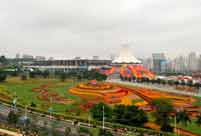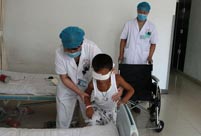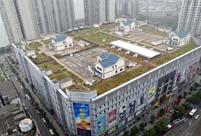Squat, shabby houses built over half a century ago still stand and harbor more than 100 households in the Alley 14 neighborhood in the center of Chengdu, capital of southwest China's Sichuan Province.
Discarded sewage and garbage on its narrow lanes is a constant eyesore and renders the place a complete mismatch to the tall modern buildings in the vicinity. Residents, mostly elderly and laid-off workers, struggle in their daily lives, from sharing the single public toilet in the area to living in cramped rooms.
"My original house here was built before New China was founded. It's separated into two rooms. The roof was originally thatch. Over the years, we added layers of shingles such as asphalt felt, asbestos, and plastic in order to prevent rain leakage," said Shi Ziqing, a resident in her 60s.
Shi's family has moved to an adjacent home more recently, but the new dwelling is barely any better in terms of living conditions.
With similar situations in many other Chinese cities, the country has begun work in earnest to do something about the problem and modernize accommodation for its increasingly urban population. Shi's family and their neighbors are currently experiencing the full force of this drive.
Under a government-led renovation plan, Alley 14 will disappear in two or three years, and it is not the only Chengdu neighborhood waiting to be renovated or demolished.
Work on Caojia Alley, also a run-down section of the city center, was officially launched in July. Under a range of settlement packages, residents are temporarily living elsewhere as they wait to return to the rebuilt Caojia Alley, being resettled in other districts or accepting compensation.
In late August, the Chengdu municipal government announced that all shantytowns will be renovated or rebuilt over the next five years, a project which will see homes totaling 15 million square meters renovated or reconstructed.
In recent years, the city has invested 30.2 billion yuan (4.9 billion U.S. dollars) in renovating 3.7 million square meters of old buildings for nearly 65,000 households.
Nationwide, the Chinese government aims to revive another 10 million homes in dilapidated neighborhoods. Between the start of 2008 and the end of 2012, 12.6 million such homes were restored.
Analysts point out that such projects are being integrated into China's new-style urbanization that improves livelihoods on the one hand, and on the other injects new vitality to the economy, which slowed to 7.5 percent in the second quarter of 2013 from 7.7 percent in the first.
The Political Bureau of the Communist Party of China Central Committee,China's top decision maker, pledged to maintain a reasonable investment increase and push "human-centered" urbanization in the second half of 2013.
Premier Li Keqiang has also reiterated the importance of human-centered urbanization. He emphasized that improving urban infrastructure and other weak sectors can not only satisfy people's aspirations, but also stimulate investment and consumption.
An annual renovation of 2 million to 3 million dilapidated homes can bring about investment of 200 billion yuan to 300 billion yuan, adding a 3-percentage points increase in investment growth, the China International Capital Corporation Ltd. has forecast.
A cabinet document released in July called for greater efforts to speed up improvements to run-down neighborhoods, and pledged greater policy aids including enhancing credit support and encouraging private investment.
Wang Zhong, governor of China Development Bank's Sichuan branch, told Xinhua that the branch signed an agreement with the Chengdu municipal government earlier this year to specifically support Chengdu's new-style urbanization. The branch will offer 100 billion yuan of credit over the next five years to help with the city's investment plans on projects such as a public transit system, urban construction and rural-urban integration.
A report by the United Nations Development Programme (UNDP) in August said that urban development served as the main force driving China's economy in the past two decades, and will continue to do so in the coming decades. It forecast that the proportion of China's population living in cities will rise to 70 percent, resulting in an additional 310 million new city dwellers.
China's urban population hit 690 million and accounted for 51.27 percent of its total population in 2011, the first time more people lived in cities than in the countryside.
But the UNDP report said China's urbanization comes at a critical time with pressure accumulating in matters such as the efficient use of natural and energy resources, development of urban governance systems, employment, transportation, housing and access to basic social services, security, and the livelihoods of migrant workers.
In Alley 14, the local government is still negotiating terms with residents, with 15 percent of them remaining unconvinced about whether to sign an agreement under the renovation plan. They fear their interests may be harmed and complain the renovation plan is not completely fair and open.
"I am afraid we could be the victims. The government officials are pushing us to agree, but why don't they just give us the money and we renovate our homes by ourselves?" said a resident who declined to provide his name for fear of coming to the attention of officials, who in turn talk of "sunshine projects" and absolute openness.
Shi Ziqing, meanwhile, is in favor of the renovation project. Having already signed an agreement, she has been working to persuade her neighbors to do the same.
Wu Shaofu, vice director of the housing management department of Wuhou District in Chengdu, said attentions have lately turned to run-down areas of the city scattered in isolated spots. Compared to large areas of old shingle-roofed houses, these smaller neighborhoods hold little commercial value for development and pose challenges.
For Wu, how he uses a fair approach to convince Alley 14 residents of the true benefits of renovation will directly determine the outcome of their new home dreams. And ultimately, it will impact upon such projects' economy-boosting efforts when they are rolled out across the country.
 DPRK holds military parade to mark 65th founding anniv.
DPRK holds military parade to mark 65th founding anniv. Highlights of MAKS 2013 Int'l Aviation and Space Show
Highlights of MAKS 2013 Int'l Aviation and Space Show  10th China-ASEAN Expo opens in Nanning
10th China-ASEAN Expo opens in Nanning Eagle Boy takes to sky to break another record
Eagle Boy takes to sky to break another record 12-year-old boy becomes pillar of the family
12-year-old boy becomes pillar of the family Eye-gouged boy receives blind rehabilitation in Shanxi
Eye-gouged boy receives blind rehabilitation in Shanxi Top 10 naked hotels in the world
Top 10 naked hotels in the world The most gorgeous Chinese women in the eyes of foreigners
The most gorgeous Chinese women in the eyes of foreigners A collection of bizarre rooftop buildings around China
A collection of bizarre rooftop buildings around China Residences of the royal house of Savoy
Residences of the royal house of Savoy China's frigate 'Bengbu'in fire training
China's frigate 'Bengbu'in fire training Fresh students 'forced' to register in university independently
Fresh students 'forced' to register in university independently 2013 Taiwan Int'l Tourism Expo kicks off in Taipei
2013 Taiwan Int'l Tourism Expo kicks off in Taipei Photo story: Take a gap year
Photo story: Take a gap year Nokia's Global Headquarters: visiting a declining empire
Nokia's Global Headquarters: visiting a declining empireDay|Week|Month